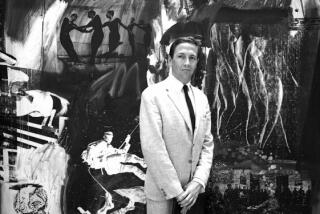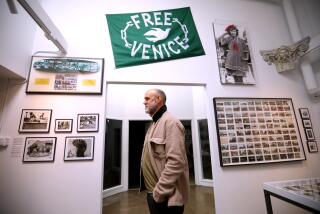Glass Artist Chihuly Prepares Huge Installation in Italy
- Share via
SEATTLE — Nobody can accuse glass artist Dale Chihuly of thinking small.
Since he discovered the art of glass-blowing as a student in the 1960s, Chihuly has helped propel the medium to the forefront of the modern art world with enormous, undulating, platter-like creations and whimsical glass sculptures assembled by 10-person teams.
Now the Seattle-based craftsman is in the final stages of his biggest project yet, the installation of some 15 towering “chandeliers” and dozens of smaller works in Venice, Italy, where he first learned the mysterious art of manipulating molten glass.
Chihuly, 54, who took teams of glassblowers to three countries for the production of “Chihuly Over Venice,” will arrive on Monday to oversee the installation of works weighing up to a ton or more in time for the city’s first Biennale of Glass, which opens Sept. 12.
While he has done large installations in restaurants, museums, galleries and even aboard a ship, he said he had never tried anything as difficult logistically as Venice. “Italy is difficult to begin with and Venice is much more complicated than most cities,” he said in the former boat factory on Lake Union that serves as his home and studio.
Chihuly, a striking figure with an eye patch and mane of wild curls, has spent more than $1 million on the Venice project involving some 300 people, probably more than has been spent for any single artistic enterprise since the conceptual artist Christo wrapped Berlin’s Reichstag in cloth last year.
Chihuly’s assistants designed special four-legged frames to suspend the 15-foot-high chandeliers without damaging historic buildings and they consulted with Boeing Co. engineers for insight into possible wind hazards in the city’s narrow waterways.
Chihuly sat through a seemingly endless series of meetings with Venetian authorities to win approval for his plans to install the giant glass assemblages over the city’s famous canals and in palaces, courtyards and gardens.
Smaller works will be tossed from bridges and floated along the waterways as homage to the ancient glassmaking center that he fell in love with as a Fulbright fellow studying at the famed Venini Factory in the late 1960s.
“It is kind of a full circle, going back there after almost 30 years,” he said. “It is my favorite city--along with about half the rest of the world’s.”
After learning at the hands of Venetian masters, the Tacoma native returned to the Pacific Northwest and in 1971 co-founded the Pilchuk Glass School north of Seattle, which has helped make the region an international center for the studio glass movement. Chihuly, who has not blown glass himself since losing his left eye in a 1976 automobile accident, has assembled a staff of some 80 artisans and assistants who turn out pieces seven days a week.
*
His frequent exhibits are hugely popular and his work is represented in permanent collections of the world’s most prestigious museums, including the Louvre in Paris and New York’s Metropolitan Museum of Art. Current prices range from $3,000 for a small “basket” to $300,000 or more for a large chandelier or ceiling installation.
“He’s one of the most successful artists in terms of both critical esteem and commercial success,” said Donald Kuspit, author of a forthcoming study of his work.
Chihuly has ruffled feathers along the way in the staid art world, where until recently glass-blowing was considered a mere craft. And he is aware that his self-titled Venice project could irritate some in the canal city, which has been a glass-making center for hundreds of years.
But Chihuly brushes aside any criticism of his brashly self-promotional style. “For everyone who didn’t like that there would probably be another 10 who would say that what Chihuly has done has really helped bring up the rest of us.”
He said he hoped that attitude would prevail among the glass masters of Venice as well. “I think when you have a big glass event it can’t help but be good for the glass scene in Venice, and I think they will probably realize that,” he said.
More to Read
The biggest entertainment stories
Get our big stories about Hollywood, film, television, music, arts, culture and more right in your inbox as soon as they publish.
You may occasionally receive promotional content from the Los Angeles Times.










